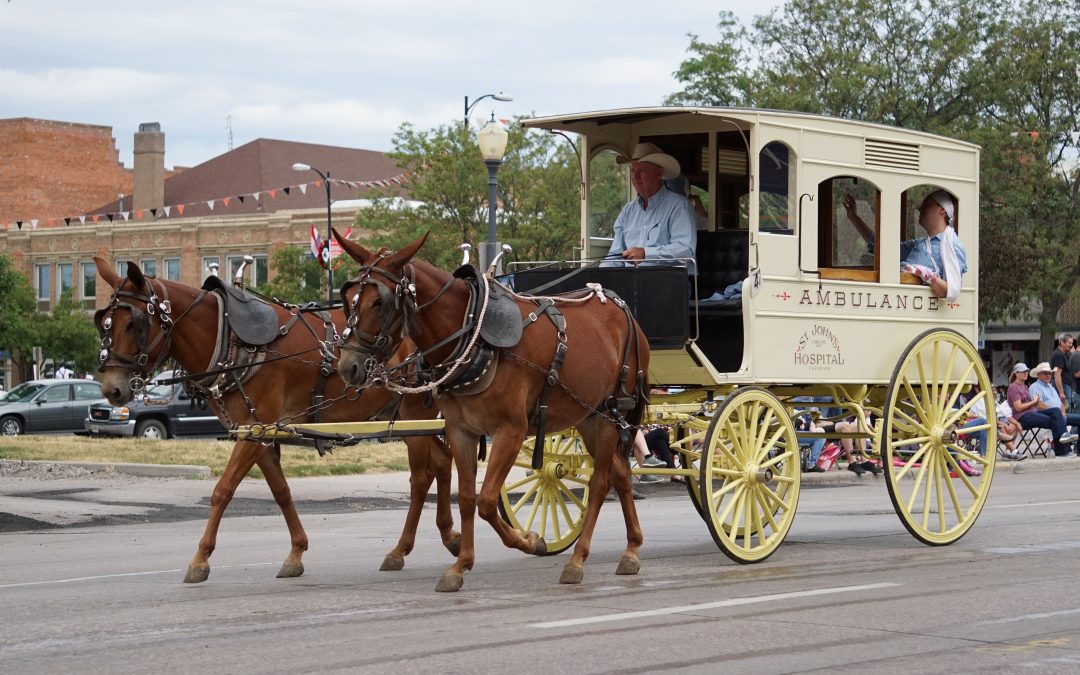The 1800s
The United States established its first known systematic and organized approach to field care for the sick and injured on the Civil War grounds.2 Volunteers on horse-drawn carts would rush out to injured soldiers, load them up on a wooden board and take them back to a medical tent. This system inspired Commercial Hospital in Cincinnati, Ohio to put the first civilian ambulance into service in 1865.2 This ambulance carried splints, a stomach pump, morphine and brandy, allowing patients to receive some sort of treatment before arriving at the hospital.3 Hospitals in larger cities, like New York City, followed suit and started running their own ambulance services.
Early 1900s
In 1905 we saw the first gas-powered ambulance, which led to the first mass-produced and sold ambulance being put into service in 1909.3 Even though these new vehicles were driving through the streets of cities back home in the states, during World War I volunteers were still manning horse and buggy-type ambulances overseas. But in World War II volunteers were replaced by professionals and thus, the field medic became an official profession.4 Back on the streets at home, the Clever cot was patented, having the frame of the modern ambulance stretcher, it gave EMS providers an easier way to move patients from a scene to the ambulance to a hospital bed.5
The 1950s
In the early fifties, the Korean war brought on the need for flight medics who could respond to remote areas quickly and make an even quicker exit.4 In the fifties and early sixties, scholarly articles started being published about initial cardiopulmonary resuscitation (CPR) that could be started by EMS providers in the field, setting patients up for better chances of survival once at the hospital.2
The 1960s
Now, if you’ve taken any EMT course you might remember that it was the National Highway Traffic Safety Administration (NHTSA) that actually became the regulator of the EMS industry. In the sixties, even though ambulances were in service in large cities all over the country, there was no consistent prehospital care established nationwide. As highways started to get busier, people were getting injured and dying in car wrecks, leading the National Academy of Sciences and the President’s Commission on Highway Safety to publish Accidental Death and Disability: The Neglected Disease of Modern Society.4 This study revealed the need for an organized and official solution to transporting the sick and injured, which inspired the government to dedicate more resources to figuring out a solution.
The 1970s
These resources went to work and the Department of Health Education and Human Services enacted the Emergency Medical Services Act of 1973 creating funding and programs to develop prehospital EMS along with an official curriculum.4 The country’s newfound investment and interest in the EMS field led to the first series of huge technological innovations to appear in the industry. We saw the, now classic, high-topped station wagon ambulances hit the streets.3 We also saw the invention of the first portable defibrillator,6 which quickly evolved into the LifePak 4 being launched in 1974 by Physio-Control. This initial model of the LifePak was the first to feature an electrocardiogram strip chart recorder, which provided a permanent, physical record of a patient’s heartbeat.7
The 1980s
In the eighties, advanced life support curriculum was added into EMT courses, establishing the next level of the EMT professional; the paramedic.4 In this decade we also saw the first automatic external defibrillator (AED), which allowed electro cardiotherapy to be delivered by lower-skilled EMS providers and even lay people.6 In the early eighties James Broselow, MD invented the Broselow tape to take some of the guesswork and fear out of treating pediatric patients.8
The 1990s
In the nineties the National Registry of Emergency Medical Technicians (NREMT) was established and the NREMT exam was developed to introduce a higher standard for entry into the EMS field.4 Hemostatic gauze was invented in 1997 to serve the troops as tensions increased in the Middle East, a great development in how trauma patients could be treated in the field beyond basic splinting and pressure dressings.8
The 2000s
With a technology boom happening post-internet and computers advancing quickly, it’s no surprise that the new millennium brought with it many technological inventions to EMS that we use to this day. Stryker put out the first battery-powered cot in 2005 which continued to evolve over the years into the now popular Stryker Power Pro, used on most ambulances in the country today.5 In 2014, the first mobile stroke unit went into service in Texas. Inside, the unit had a portable CT scan and tPA drugs, bringing the hospital to the door of the patient’s house, a massive advancement in the treatment of strokes in EMS.10 In 2022 Hinckley Medical launched OneWeight™, the first-ever stretcher scale, and OneDose™, a protocol management app that syncs with the scale to populate weight-based medication doses in real time based on actual patient weight. These products bring hospital-level precision to the back of any ambulance. Read more about their impact on EMS here.
Present Day
So what’s next in EMS? We’ve come all the way from horse-drawn carts stocked with brandy all the way to miniature hospital rooms on wheels equipped with amazing technology in astonishingly small sizes. With artificial intelligence, virtual reality and new technologies coming out every day, it is nearly impossible to predict what innovations are on the way, but it’s our mission at Hinckley Medical to make sure we keep pushing innovation in EMS for the next 50 years and beyond.
Sources:
2https://www.emra.org/about-emra/history/ems-history
3https://indianahealth.care/history-of-ems
4Emergency Care and Transportation of the Sick and Injured Textbook, Twelfth Edition by American Academy of Orthopaedic Surgeons (AAOS)
5https://emsmuseum.org/collections/archives/cots-and-stretchers/cots-yesterday-today/
8https://epmonthly.com/article/from-humble-beginnings-the-birth-of-the-broselow-tape/

